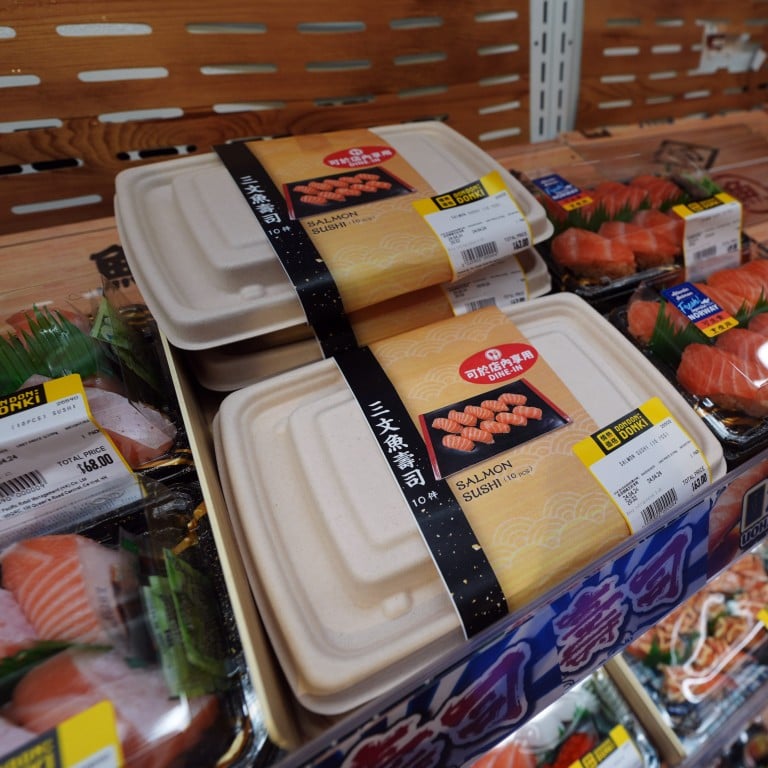
Explainer | How sushi became a raw topic for Hong Kong’s plastics ban. The Post unboxes the saga
- First phase of ban took effect on Monday, prohibiting polystyrene products, disposable plastic utensils for dine-in or takeaway meals
- But confusion over which containers should be used for pre-packaged sushi from supermarkets has sparked backlash and calls for clarity
Critics also said the incident reflected the ambiguity and confusion resulting from the ban, with some residents unsure about which circumstances determined if an item was prohibited.
The Post shines a light on the saga and explains what readers need to know.
What happened?
Don Don Donki, a major Japanese discount chain in Hong Kong, started replacing some of its transparent plastic sushi containers with cardboard boxes earlier this week, as part of efforts to comply with the new ban.
The change meant some sushi dishes meant for takeaway were packed in the regular plastic boxes, while those intended for diners eating at their stores were given the cardboard containers.
But the biodegradable cardboard boxes only showed a picture of the food on top, with some diners saying the decision left them guessing over the presentation quality of their meals.
The company also posted signs at store entrances to remind customers that plastic throwaway containers could not be used for dine-in dishes.
Some shoppers at Don Don Donki in Causeway told the Post they were concerned about food safety and preferred to see their sushi when making the purchase, while others said the convenience of dining in outweighed the food’s appearance.

What does Hong Kong’s plastics ban entail?
The first phase of Hong Kong’s ban on single-use plastic took effect on Monday, including a six-month grace period to give businesses time to clear out their inventories of prohibited items.
The policy prevents restaurants from offering customers any polystyrene products, disposable plastic straws, stirrers, cutlery or plates for dine-in or takeaway meals.
The ban also covers items used by patrons dining in, such as single-use cups, cup lids and food containers.
Restaurants are still allowed to serve food or drinks in throwaway plastic containers for takeaway orders, but the items cannot be made from styrofoam.
Once the grace period expires, offenders can face a maximum fine of HK$100,000 (US$12,765) and may also be required to pay HK$2,000 under a fixed penalty system.
The second phase of the ban could start from next year and will prohibit all use of throwaway plastics at restaurants, including food containers, six-pack yokes for canned drinks, tablecloths, disposable gloves and plastic-stemmed dental floss.
All you need to know about Hong Kong’s new ban on single-use plastics – a complete visual guide
What is the government’s response?
The Environmental Protection Department on Thursday evening issued a statement saying retailers such as supermarkets selling pre-packaged food on their shelves for immediate consumption could categorise them as takeaway items.
“Therefore plastic cups and plastic food containers can be used. Where the customers consume the product is not relevant,” it said.
But the supermarkets with on-site dining areas serving cooked food would be considered to be offering dine-in services and subject to the same rules as restaurants, it added.
“This situation is similar to the mode of operation of a food court, and no different from that of a regular restaurant,” the department argued.
Hong Kong authorities under fire after clarification over sushi served in plastic
How are people reacting?
Lawmaker Peter Shiu Ka-fai urged authorities to put more effort into explaining the ins and outs of the ban to residents and industry players to help clear up any grey areas.
He offered an example where a retailer might be selling both pre-packaged and made-to-order fried chicken on its premises.
The first product would be considered takeaway, while the second one was subject to dine-in rules, Shiu told a radio show on Friday.
“Consumers might think, why do different regulations apply when I am buying the same product at the same place? This will lead to confusion,” he said.
The legislator said some businesses in the retail and catering sectors had told him they did not fully understand the new rules.
“Some of them have been concerned about whether they are still allowed to use transparent plastic boxes,” Shiu said. “The government has made clarifications, but I think it still needs to engage stakeholders and businesses to do more explanations on the new regulations.”
Will picking sushi in Hong Kong become more of a lottery under plastics ban?
Lawmaker Doreen Kong Yuk-foon raised concerns over whether the department’s explanation meant supermarkets could still use the plastic containers for dine-in purposes under the ban.
Kong, who served on a committee that scrutinised the plastics ban bill, said the explanation was not in line with the law, accusing the department of only creating more confusion.
Under the Product Eco-responsibility (Amendment) Ordinance, a caterer is engaged in dine-in services when “the purpose of serving the food or drink [is] for consumption on the premises”.
“It was too eager to reassure the chain stores that they can place sushi in plastic boxes without going through what is written in the law and what they have told the sector before,” she said.
“Such a mistake is totally avoidable and the officials in charge of this should be held accountable for creating such conflicting statements and misinterpreting the law.”

